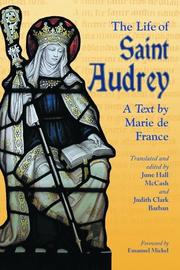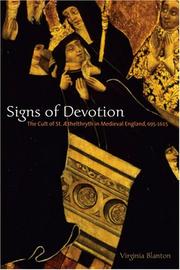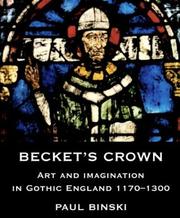| Listing 1 - 7 of 7 |
Sort by
|

ISBN: 9780786426539 0786426535 Year: 2006 Publisher: Jefferson McFarland
Abstract | Keywords | Export | Availability | Bookmark
 Loading...
Loading...Choose an application
- Reference Manager
- EndNote
- RefWorks (Direct export to RefWorks)
"Written by a woman in an age when women rarely wrote and signed by one who calls herself Marie in an epilogue strikingly similar to that of the Fables of Marie de France, the Vie seinte Audree is a late 12th or early 13th-century Anglo Norman text. "--Provided by publisher.
Book
Year: 1975 Publisher: Ely: Dean and chapter of Ely,
Abstract | Keywords | Export | Availability | Bookmark
 Loading...
Loading...Choose an application
- Reference Manager
- EndNote
- RefWorks (Direct export to RefWorks)

ISBN: 9780271029849 0271029846 Year: 2007 Publisher: University Park. Pa Pennsylvania State University Press
Abstract | Keywords | Export | Availability | Bookmark
 Loading...
Loading...Choose an application
- Reference Manager
- EndNote
- RefWorks (Direct export to RefWorks)
Christian church history --- Etheldrada van Ely --- Christian hagiography. --- Christian saints --- Hagiographie chrétienne --- Saints chrétiens --- Cult --- History --- Culte --- Histoire --- Etheldreda, --- Cult. --- England --- Angleterre --- Church history --- Sources. --- Histoire religieuse --- Sources --- Christian hagiography --- Hagiographie chrétienne --- Saints chrétiens --- Christian saints - Cult - England - History - To 1500 --- Etheldreda regina abb. Eliensis --- Etheldreda, - Queen of Northumbria, - 630-679 - Cult --- England - Church history - Sources --- Etheldreda, - Queen of Northumbria, - 630-679

ISBN: 0198208154 9780198208150 Year: 2004 Volume: *37 Publisher: Oxford Clarendon
Abstract | Keywords | Export | Availability | Bookmark
 Loading...
Loading...Choose an application
- Reference Manager
- EndNote
- RefWorks (Direct export to RefWorks)
Christian hagiography --- Christian women saints --- Hagiographie chrétienne --- Saintes chrétiennes --- Hagiographie chrétienne --- Saintes chrétiennes --- Christian saints, Women --- Women Christian saints --- Christian saints --- Women saints --- Hagiography, Christian --- Hagiography --- Christian women saints - England - Ely --- Ely --- Saintes --- Withburga v. regia in Anglia --- Etheldreda regina abb. Eliensis --- Sexburga regina abb. Eliensis --- Werburga seu Wereburga abb. Eliensis --- Ermenilda regina Merciae et abb. Eliensis

Abstract | Keywords | Export | Availability | Bookmark
 Loading...
Loading...Choose an application
- Reference Manager
- EndNote
- RefWorks (Direct export to RefWorks)
Architecture, Gothic --- Church architecture --- Liturgy and architecture --- Architecture and religion. --- Architecture gothique --- Architecture chrétienne --- Liturgie et architecture --- Architecture et religion --- England --- Angleterre --- Church history --- Histoire religieuse --- Architecture and religion --- Architecture chrétienne --- Architecture [Gothic ] --- Architecture religieuse --- Architecture, Gothic - England --- Church architecture - England --- Liturgy and architecture - England --- Art gothique --- Thomas ep. Cantuariensis m. --- Hugo ep. Lincolniensis --- Etheldreda regina abb. Eliensis --- England - Church history - 1066-1485
Book
ISBN: 1843844028 9781843844020 9781782044666 1782044663 Year: 2015 Publisher: Suffolk : Boydell & Brewer,
Abstract | Keywords | Export | Availability | Bookmark
 Loading...
Loading...Choose an application
- Reference Manager
- EndNote
- RefWorks (Direct export to RefWorks)
The past was ever present in later medieval England, as secular and religious institutions worked to recover (or create) originary narratives that could guarantee, they hoped, their political and spiritual legitimacy. Anglo-Saxon England, in particular, was imagined as a spiritual 'golden age' and a rich source of precedent, for kings and for the monasteries that housed early English saints' remains. This book examines the vernacular hagiography produced in a monastic context, demonstrating how writers, illuminators, and policy-makers used English saints (including St Edmund) to re-envision the bonds between ancient spiritual purity and contemporary conditions. Treating history and ethical practice as inseparable, poets such as Osbern Bokenham, Henry Bradshaw, and John Lydgate reconfigured England's history through its saints, engaging with contemporary concerns about institutional identity, authority, and ethics. Cynthia Turner Camp is an Assistant Professor of English at the University of Georgia.
Christian hagiography --- Christian saints --- History --- Great Britain --- Christian hagiography - History - To 1500 --- Christian saints - England --- Anglo-Saxon --- Editha abb. Wiltoniensis --- Etheldreda regina abb. Eliensis --- Werburga seu Wereburga abb. Eliensis --- Eduardus Confessor rex Anglorum --- Saints --- Fremundus rex m. in Anglia --- Great Britain - History - Anglo-Saxon period, 449-1066 --- Great Britain - History - Medieval period, 1066-1485 --- Anglo-Saxons --- Canonization --- Anglo-Saxon saints. --- Ethics. --- Henry Bradshaw. --- History writing. --- Institutional identity. --- John Lydgate. --- Late medieval England. --- Osbern Bokenham. --- Precedent. --- Spiritual "golden age".
Book
ISBN: 9782503528366 2503528368 9782503562759 2503562752 Year: 2009 Volume: 25 Publisher: Turnhout Brepols
Abstract | Keywords | Export | Availability | Bookmark
 Loading...
Loading...Choose an application
- Reference Manager
- EndNote
- RefWorks (Direct export to RefWorks)
Saints Edith and Æthelthryth: Princesses, Miracle Workers, and their Late Medieval Audience narrates the lives of two Anglo-Saxon princesses who were venerated as saints long after their deaths. St Edith, the daughter of King Edgar, was renowned as a patron of the arts and the church during her lifetime; her posthumous miracles included protection of Wilton Abbey and the English royal family. St Æthelthryth, who retained her virginity through not one but two royal marriages, also worked numerous miracles at her tomb at the Abbey of Ely. The poems, composed at Wilton Abbey in the early fifteenth century, allow us to see how late medieval religious women practised their devotion to early medieval women saints. The Middle English verse texts are presented here in the original and in translation with explanatory notes and glossary. A thorough introduction provides extensive contextualization and analysis of the two poems as well as description of the manuscript and its language and prosody. These primary source texts are important contributions to the study of English history, language, literature, religion, and women's studies.
Christian spirituality --- Edith of Wilton --- Christian women saints --- Christian poetry, English (Middle) --- Saintes chrétiennes --- Poésie chrétienne anglaise (moyen anglais) --- Poetry. --- History and criticism. --- Poésie --- Histoire et critique --- Edith, --- Aethelthryth, --- History and criticism --- Etheldreda, --- Saintes chrétiennes --- Poésie chrétienne anglaise (moyen anglais) --- Poésie --- Edith de Wilton --- Poetry --- Etheldreda --- Christian poetry [English ] (Middle) --- Christian women saints - Poetry --- Christian poetry, English (Middle) - History and criticism --- Etheldreda regina abb. Eliensis --- Editha abb. Wiltoniensis --- Edith, - Saint, - d. ca. 986 - Poetry --- Etheldreda, - Queen of Northumbria, - 630-679 - Poetry --- Edith, - Saint, - d. ca. 986 --- Etheldreda, - Queen of Northumbria, - 630-679 --- Edith (sainte) --- Poésie chrétienne --- Poésie anglaise --- 1100-1500 (moyen anglais)
| Listing 1 - 7 of 7 |
Sort by
|

 Search
Search Feedback
Feedback About UniCat
About UniCat  Help
Help News
News